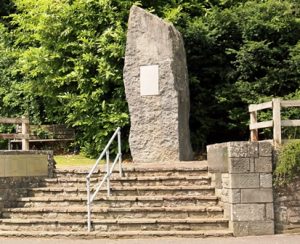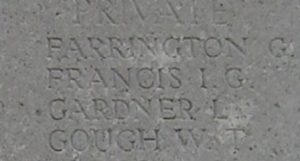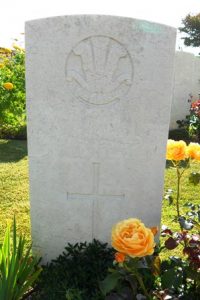Tretower is a hamlet in the community of Llanfihangel Cwmdu, together with Bwlch and Cathedine, in the southern part of the county of Breconshire, and lies on the A479 road within the Brecon Beacons National Park at the foot of the Black Mountains just off the Usk Valley. The hamlet is home to the impressive Tretower Court and the nearby ruins of Tretower Castle. Tretower Church in the village is dedicated to St John the Evangelist. The men of Tretower who fell during both World Wars are commemorated on the Crickhowell and District War Memorial, which is located in Crickhowell, near to the site of the former Crickhowell War Memorial Hospital.

The Great War, 1914-1918
John Vaughan Edwards, Corporal, 235066, Royal Gloucestershire Hussars. John was the son of Walter Edwards and Sarah Jane Edwards (nee Richards), of Middle Gaer, Bwlch. He worked on his parent’s farm prior to enlisting at Crickhowell into the Royal Gloucestershire Hussars soon after the outbreak of war. The battalion was a Territorial Army unit which mobilised at Gloucester on 4 August 1914 as part of the 1st South Midland Mounted Brigade. The brigade moved to the Bury St. Edmunds area to join the 1st Mounted Division, then moved to Newbury to join the 2nd Mounted Division. During November 1914 the Division moved to the Kings Lynn area, before embarking for Egypt and landed at Alexandria on 2 April. In August 1915 the Royal Gloucestershire Hussars landed at Gallipoli with the 2nd Mounted Division and remained on the Peninsula until being evacuated in December 1915 and returned to Egypt. During January 1916 the 2nd Mounted Division broken up and the 1st South Midlands Mounted Brigade became the 5th Mounted Brigade which was independent. The Brigade operated along the Suez Canal Defences until February 1917 when it joined the Imperial Mounted Brigade and from March onwards took part in the advance into Palestine. On 26 March, the Royal Gloucestershire Hussars, temporarily attached to the 53rd (Welsh) Division, was deployed along the coast, covering the division’s left flank as it attacked Gaza from the south. The attempt to capture Gaza suffered from delays caused by fog, and the attack was called off in the late afternoon. A second attempt to force Gaza was launched on 17 April, which also failed, and the EEF suffered a change in leadership, with Sir Edmund Allenby assuming command, before being re-organised, and a third offensive was launched against a wider front from Beersheba to Gaza on 31 October 1917. This time the Turkish defences were breached, and the road to Jerusalem now lay open and the EEF began to advance north. On 12 November 1917 the Royal Gloucestershire Hussars became caught up in heavy fighting during a defensive action immediately before the Battle of Mughar Ridge, when a Turkish counterattack pushed the 5th Mounted Brigade back from Balin. John was killed in action during the fighting that day. The 28-year-old was reportedly buried at Somniel, but his grave must have been lost afterwards as he is commemorated on the Jerusalem Memorial, Israel.
Ivor Gordon Francis, Private, 27357, South Wales Borderers. Ivor was the son of Philip Francis and Christina Francis, of Igllys, Tretower. He married Margaret Ann Williams in 1916 and the couple had two children, Elizabeth and Ivor, born over the next two years. Ivor enlisted into the South Wales Borderers at Brecon and was drafted out to France soon after his marriage, joining the 2nd Battalion, South Wales Borderers. He was subsequently transferred to the 6th Battalion, South Wales Borderers, which was the Pioneer Battalion to the 25th Division. Ivor probably joined the battalion on the Somme, where it remained before moving to the Ploegsteert Sector, where the Division held the line for the months leading up the Battle of Messines in June 1917. After fighting at Messines, the Division fought at the Pilckem Ridge, before moving south to the Arras Sector, taking up positions around Bullecourt in reserve. Here the Division was used to reinforce the badly depleted British units that were hit in the area by the German Spring Offensive of 21 March 1918. The Division then moved north to Flanders on the night of 30 March, where it took up positions at Ploegsteert again. On 9 April the Germans launched the second phase of their Spring Offensive along the Lys Valley, and the Division was caught up in the terrible fighting which ensued. The Division withdrew to Abeele to rest on 17 April, but on 25 April was ordered back into the line, and took part in the Second Battle of Kemmel. On 9 May the Division moved to Fismes, 20 miles south-east of Soissons in the Champagne, to give it a chance to rest and rebuild again. On 26 May the Division took up positions south of the Aisne, to guard against a predicted German Offensive. On the following morning, 27 May, the Germans hit the Division, and during the coming days the Division was virtually annihilated. Ivor was reported to have been killed by a German artillery shell on 28 May 1918. The 23-year-old has no known grave and is commemorated on the Soissons Memorial, France.

David John Games, Private, 36756, Northumberland Fusiliers. David was born on 12 April 1886, the son of David and Mary Catherine Games, of Woodland Cottage, Tretower. On 24 October 1905 he began work as an engine cleaner for the Great Western Railway at Aberbeeg Station, but by 1911 he was lodging at 10, Caroline Street, Llanelli, where he worked as an electrical linesman. David was living at Newport when war broke out and married Elsie May Sawtell there on 1 March 1916. He enlisted at Crickhowell into the army and upon being drafted to France was posted to the 24th Battalion, Northumberland Fusiliers, which was attached to 103 Brigade, 34th Division. The Division saw its first major action on the Somme on 1 July 1916, where it suffered very severe casualties during its part in the attack on La Boiselle. It then took part in the Battle of Bazentin Ridge and in the ensuing Battle of Pozieres and the Battle of Flers-Courcelette. The following year saw the Division move north to the Arras Sector where it took part in the First and Second Battles of the Scarpe, and then in the Battle of Arleux. On 10 August 1917 the 24th Battalion, Northumberland Fusiliers amalgamated with the 27th Battalion to form the 24/27th Battalion, Northumberland Fusiliers, in the same 34th Division. By now the Division was holding the line near Hargicourt. The 24/27th Battalion then began to rotate for duty in the front line, usually spending four days in the line, four in support, and four in reserve. At the end of September, the Division was relieved and moved to Proven, in the Ypres Salient, before taking over positions near Poelcapelle, to join the great push to capture the Passchendaele Ridge. David was killed in action when the battalion supported an attack by the 18th Division near Poelcapelle on 23 October 1917. The 31-year-old has no known grave and is commemorated on the Tyne Cot Memorial, Belgium. David does not appear to be commemorated locally.
William John Powell, Private, 57100, Welsh Regiment. William was born on 23 December 1896, the son of William Powell and Ellen Powell (nee Morgans), of Old Vine Tree Cottage, Tretower. He worked as a farm labourer prior to enlisting into the 2/1st Battalion, Glamorgan Yeomanry at Bridgend on 13 December 1915 and joined the battalion in Suffolk. On 4 August 1916 William embarked for France and was posted to the 14th (Swansea) Battalion, Welsh Regiment, which was at Ypres attached to 114 Brigade, 38th (Welsh) Division. On 19 September he was taken ill and admitted to the 129th Field Ambulance. Ten days later he re-joined his battalion, which was on the Canal Bank defences at Boesinghe, then was temporarily attached to the 123rd Field Company, Royal Engineers for a short while. During this period, the infantry battalions of the Division were carrying out the normal pattern of rotation in the trenches, four days in the front, four in support and four in reserve, whilst also working on trench improvement, digging new trenches, and also carrying out regular patrols and trench raids, whilst preparing for the forthcoming Passchendaele offensive. On 31 July 1917 the Division launched its famous assault on the Pilckem Ridge, capturing Iron Cross and reaching its objective of the Steenbeek. William was killed in action at some time during the assault that day. The 21-year-old was originally buried on the battlefield, but his grave was found during the post-war battlefield clearances and on 28 June 1920 his body was re-buried in Poelcapelle British Cemetery, Belgium.

Arthur Wargent, Rifleman, R/39067, King’s Royal Rifle Corps. Arthur was the son of Sydenham Wargent and Elizabeth Wargent (nee Gregg), of The Firs, Tretower. He enlisted into the army at Brecon during the winter of 1916-17 and after completing his training was drafted to France in the summer of 1917 and was posted to the 9th Battalion, King’s Royal Rifle Corps. The battalion was attached to 42 Brigade, 14th (Light) Division, which was at the time of his arrival holding a section of the front in the Arras Sector. The Division had taken part in heavy fighting during the First Battle of the Scarpe, and later at the Third Battle of the Scarpe in May 1917, as part of the Arras offensive. The 9th KRRC suffered heavy casualties at Arras, so Arthur would have been among a large number of drafts as the battalion rebuilt at Puchevillers in June. On 12 July the battalion entrained for Flanders, detraining at Bailleul later that day. The Division remained around Bailleul whilst the opening assault of the Passchendaele offensive began on 31 July, then on 6 August began moving into the Ypres Salient, taking up positions near Zillebeke, before joining the great battle. The Division then took part in the Battle of Langemarck and had a brief rest before taking part in the First Battle of Passchendaele and the Second Battle of Passchendaele. At the end of December, the Division was relieved and entrained for the Somme, reaching Suzanne by 1 January 1918, before moving into the trenches in front of Benet, near Montescourt, and the infantry battalions began the routines of trench rotation. On 19 March the 9th KRRC moved back into the front line to begin a routine tour, but by now many of the British troops felt that the Germans were preparing for something. At dawn on 21 March 1918 a tremendous artillery barrage was opened up by the Germans along a stretch of the line running south from Croisilles to La Fère and soon afterwards followed it up by a massed infantry assault. The 9th KRRC was hit on the left flank and on its front and fought valiantly throughout that terrible first day. Arthur was posted as missing during the ensuing fighting that day and was afterwards declared as having been killed in action on 21 March 1918. The 19-year-old has no known grave and is commemorated on the Pozieres Memorial, France.
Ebenezer William Watkins, Private, 201278, South Wales Borderers. Ebenezer was the son of Evan Watkins and Annie Watkins (nee Bevan), of Llwyncrwn Farm, Crickhowell. He worked as a horseman on his parent’s farm prior to the war. Ebenezer enlisted at Brecon into the 2/1st Brecknockshire Battalion, South Wales Borderers at Brecon at some time after the outbreak of war and was drafted out to India in 1916, joining the 1/1st Brecknockshire Battalion, which was on garrison duty at Mhow. Ebenezer sadly became ill whilst in India and died of disease at Mhow on 24 October 1918, less than a month before the Armistice. The 29-year-old was buried in a mass grave in Mhow New Cemetery, Madhya Pradesh, so is commemorated on the Kirkee 1914-1918 Memorial, India.
Charles Williams, Lance Corporal, 201740, South Wales Borderers. Charles was born at Abergavenny in 1883, the son of Thomas and Sarah Williams. By 1901 he was lodging at Gilfach Cottage, Tretower and worked in the village as a groom. Charles married Elizabeth Hannah Jones at Tretower in 1909 and the couple set up home at Pontybrynhir, Cwmdu. Charles had by then began work as a domestic chauffeur. He enlisted at Brecon into the Brecknockshire Battalion, South Wales Borderers. The battalion mobilised at Brecon on 4 August 1914 as part of the South Wales Brigade, Welsh Division, before moving to Pembroke Dock and then to Dale, on the Milford Haven Defences. Charles remained at home for a while when the battalion embarked for the Middle East, so missed out on its torrid spell in Aden. He embarked for the Middle East among a reinforcement draft on 3 July 1915 and disembarked in Mesopotamia. By now the battalion had been transferred from Aden and was on its way to India. Charles, in the meantime, upon his arrival in Mesopotamia, was attached to the No 2 Wireless Signal Section Squadron in Basra. He served in Mesopotamia for over a year before contracting dysentery and died at Basra on 7 November 1916. The 33-year-old is buried in Basra War Cemetery, Iraq.
World War Two, 1939-1945
Gwyn Thomas Williams, Trooper, 7963012, Reconnaissance Corps. Gwyn was the son of Lemuel Williams and Lily May Williams (nee Whitney), of Llangynidr. He enlisted into the army and was posted to the 43rd (Wessex) Regiment, Reconnaissance Corps. The regiment had been formed in 1941 from the 2/5th Battalion, Gloucestershire Regiment, a Territorial Army unit which had fought with the 48th (South Midland) Division of the BEF in France in 1940. After its formation the regiment became transferred to the 43rd (Wessex) Division, before becoming part of the Royal Armoured Corps. The regiment remained in Britain for the coming years, but following D-Day, embarked at West India Docks, London aboard the Motor Transport Ship Derrycunihy on 18 June 1944, to join the invasion forces in Normandy. The ship arrived off Sword Beach on the evening of 20 June, however high seas prevented disembarkation, so Derrycunihy was moved to Juno Beach for disembarkation. As the ship started engines at 07.40 on the morning of 24 June 1944 it detonated an acoustic German mine which exploded under the keel, splitting the ship in two. An ammunition lorry aboard the ship subsequently exploded and in the ensuing explosion and sinking, some 183 men of the 43rd Regiment died. Gwyn was 20 years old when he was killed in the terrible tragedy that day. He has no known grave and is commemorated on the Bayeux Memorial, France.